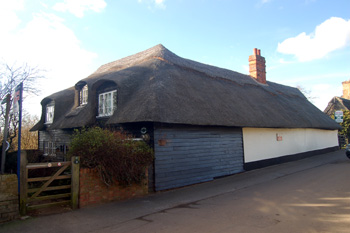
3 Brook Lane February 2011
3 Brook Lane, formerly numbered 3 to 7 Brook Lane was once, as the old numbering suggests, three separate dwellings; they were known as Church Cottages. The structure was listed by the former Department of Environment in March 1973 as Grade II, of special interest. The cottages formed part of the Flitton Town Land Charity.
The Department of Environment dated the structure to the 17th or 18th centuries. The building is timber-framed and clad partly in colourwashed roughcast render and partly in weather-boarding. It has a hipped, thatched roof. Originally each cottage had a single room downstairs with bed spaces in the attic. A 20th century extension of one storey with attics projects to the rear at the south end, forming an L-shape. The building faces west, in other words, away from the road.
The cottages are not included in a terrier of Town Land Charity or a lease of land including the Town Barn, both of 1681 [P12/1/5]. The fact that the cottages were later part of the Town Land Charity raises the interesting possibility that they may have been built as the parish workhouse. Today workhouses are remembered as large, bleak, prison-like structures where the poor were sent to live and labour. These, however, were a 19th century creation – the Poor Law Amendment Act of 1834 setting up Poor Law Unions, which contained a number of parishes, which could send their paupers to the Union workhouse – in Bedfordshire these were built in Ampthill, Bedford, Biggleswade, Leighton Buzzard, Luton and Woburn. Not all paupers were sent to such institutions as many were given funds to help them get by at home, which had been the case since the 16th century.
Before this each parish dealt with it own poor and one of the ways they did this was to have a parish workhouse where the poor people without a home of their own could be sent to labour for their keep. This idea originated in the late 1590s. Knatchbull's General Workhouse Act 1723 empowered parishes to build workhouses and by 1776 there were reckoned to be about two thousand in England. The parish register for Flitton from 1762 to 1781[P25/1/6] includes the following memorandum: "Received on the 24th day of day [sic] of December 1774, the Right Honorable [sic] the Earl of Hardwicke, by the hands of Mr. Joseph Cole, the sum of twelve pounds and twelve shillings, being his Lordship's benefaction towards rebuilding the poors house at Flitton". If Church Cottages were the parish workhouse, as we have seen they were not in existence in 1681 which suggests that they were built after the 1723 act, perhaps quite soon afterwards if they needed a considerable sum expended to repair them in 1774.
On 7th April 1924 fire insurance was taken out on the cottages with Eccesiastical Insurance Office [P12/25/1/2]. The building then comprised just two cottages, described thus: "two Cottages with Offices adjoining, built of brick, stud, timber and lath and plaster and roofed with thatch, known as Church Cottages situate Flitton". The insurance value was £480. Also included was a "Washhouse and timber and asphalted Barn adjoining, detached near the above", insured for £40. These figures were the same in 1941 when the barn was described as two warehouses [P12/25/1/11].
The Rating and Valuation Act 1925 specified that every building and piece of land in the country was to be assessed to determine its rateable value. The valuer visiting Church Cottages [DV1/C270/4-5]. Identified that the two former cottages at the south-eastern end of the structure had become one and was occupied by C. Pettit for £6/15/- per annum, pre-war rent had been £5/10/-. Accommodation consisted of a living room and small kitchen; two bedrooms in the roof and a washhouse shared with next door. The other dwelling was occupied by T. Willingham at £6/15- per annum rent, (again previously £5/10/-) he had a living room and a small kitchen and just one bedroom in roof.
By 1962 the Parochial Church Council (PCC), as administrators of the Town Land Charity had decided to demolish Church Cottages, which Ampthill Rural District Council (RDC) had scheduled for demolition [P12/25/1/13]. They were to be replaced by two or four Housing Association dwellings for old people. At that date the two tenants were a Mrs. Willingham, who died in 1962 and a Mr. Dyke, aged 67and his family. The diocesan architect then opined that eight to ten houses could be built on the site once it had been cleared. In the event Ampthill RDC refused planning permission for ten old people's dwellings [ARDC/TP/63/69] on the basis that this would form an intrusion in an area of pleasant open countryside. The PCC appealed but lost. In 1963 it was noted that the three original cottages "have only been two in living memory. These are beyond any hope of modern standards and we have agreed on demolition" [P12/25/1/15]. The comment was also made: "The two cottages have defeated the objects of the Charity since repairs have exceeded the rents extracted from them".
By the 1970s the PCC planned to sell the cottages which could be demolished and the site redeveloped for modern private housing. The money gained could then be used to pay for the substantial repairs that the church needed. A price of £8, 250 was agreed upon [P12/25/1/25]. The plan caused considerable controversy [P12/28/28/12-16 and P12/25/1/1] and clearly did not happen since Church Cottages are still with us today [2011], though now one dwelling instead of two or three.